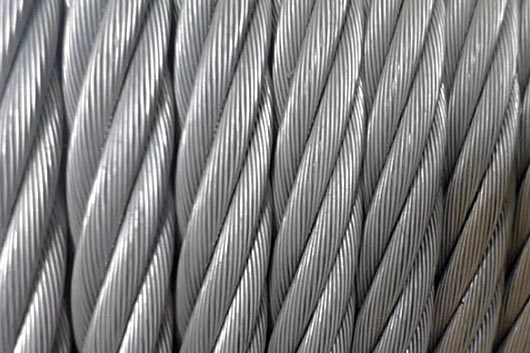1. Did you know that insufficient lubrication can dramatically reduce the service life of a wire rope?
2. Did you know that if the outer wires of a rope begin to flatten, as a result of friction, it is time to replace the wire rope?
3. Did you know that when a wire rope is crushed, damage to the structure of the rope has occurred?
4. Did you know that when a wire rope is exposed to an electrical charge, resulting in arcing, the rope has been damaged and should be replaced?
5. Did you know that a wire rope should be replaced when the inner core has begun to appear through the outer strands?
6. Did you know that kinks damage and significantly reduce the strength and integrity of a wire rope?
7. Did you know that wire rope which is in continuous service should always be inspected during operation?
8. Did you know that wire rope with cut wires, or cut strands should be replaced?
9. Did you know that if a wire rope is burned, or exposed to excessive heat it should be replaced?
10. Did you know that a wire rope with severe rust, or discoloration on the exterior is an indication of corrosion on the interior?
11. Did you know that if strands on a wire rope open up in a cage like formation the rope should be replaced? This is often referred to as "Bird Caging".
12. Did you know that wire rope will fail if worn out?
13. Did you know that wire rope is a machine?
14. Did you know that the strength of a wire rope increases slightly following a break in period, and then gradually reduces strength over the service period?
15. Did you know it is a "best practice" to replace a wire rope when you are in doubt?
16. Did you know that a wire rope should be replaced if the wear on the individual wires exceeds one third (1/3) of their original diameter?
17. Did you know that ASME B30.9 - 2006 9-2.9.4 Removal Criteria outlines the specifics for removing wire rope slings from service?
ASME B30.9 - 2006 9-2.9.4 Removal Criteria states:
A wire rope sling shall be removed from service if conditions such as the following are present:
(a) missing or illegible sling identification (see Section 9-2.7)
(b) broken wires
(1) for strand-laid and single-part slings, ten randomly distributed broken wires in one rope lay
(2) for cable-laid slings, 20 broken wires per lay
(3) for six-part braided slings, 20 broken wire per braid
(4) for eight-part braided slings, 40 broken wire per braid
(c) severe localized abrasion or scraping
(d) Kinking, crushing,birdcaging, or any other damage resulting to the rope structure
(e) evidence of heat damage
(f) end attachments that are cracked, deformed, or worn to the extent that the strength of the sling is substantially affected
(g) Severe corrosion of the rope, end attachments, or fittings
(h) for hooks, removal criteria as stated in ASME B30.10
(i) for rigging hardware, removal criteria as stated in ASME B30.26
(j) other conditions, including visible damage, that cause doubt as to the continued use of the sling"
Note: the above quoted from Bill Teichgraber (Northern Metalic Sales-Wire Rope & Rigging Business Development https://www.linkedin.com/pulse/did-you-know-bill-teichgraber)
Through the above, we understand the failure reasons of wire rope. However, how can we know a wire rope has been damaged and should be replaced? Wire rope which is in continuous service should always be inspected during operation, as Bill Teichgraber says, we need a valid method of wire rope inspection. TST provides a wide range of wire rope inspection solutions that can be applied to different industries and diverse wire rope and steel cord conveyor belt operating scenes. The applications of wire rope inspection include open-pit mine conveyor-belts, underground conveyor belts, underground mine hoisters, port cranes, construction cranes, residential and commercial elevators, cableways and etc. TST-FDSys™ and TST-FDSol™ can be installed in the forms of portable, realtime wire-rope, realtime conveyor-belt, real-time elevator or customized detecting systems for wire rope safety. The commitment of TST Team is to find solutions for more efficient and safer wire rope operations, and materialize real economic benefits from the improvement of wire rope safety management.
1. Product List of TST Flaw Detection System(TST FDSysTM)
TST-FDSysTM---The system is created by TST scientists and engineers to automatically inspect the physical flaws on the wire ropes and steel-cord conveyor belts. Given the inspected flaw data, the system can thus make evaluations of the wire rope safety status and operating performance of the targets. For the onsite engineers and operating managers, TST-FDSysTM will provide both realtime wire rope inspection monitor alongside the producing operation and comprehensive report at end of per inspection task. Therefore, flaws on the inspecting target will be noticed instantly wherever it appears and the automatically generated report will demonstrate the overall status of the target with detailed analysis of each inspected flaw. TST-FDSysTM includes:
TST FDSysTM – PORTABLE
TST FDSysTM – REALTIME WIRE ROPE
TST FDSysTM – REALTIME CONVEYOR BELT
2. More Than Detecion -- TST VIPER Wire Rope Lubricator
TST VIPER wire rope lubricator system is designed by Australian latest technology to lubricate wire rope sizes from 8mm to 165mm. It provides fast and effective single pass lubrication of wire ropes, eliminating the slow and arduous task of manual wire rope lubrication. TST VIPER wire rope lubrication system provides superior protection against corrosion and fretting wear by forcing lubricant into the core of the wire rope while also coating the outer strands. The use of TST VIPER wire rope lubrication system improves wire rope safety and reduces the environmental impact of wire rope lubrication for operation.
More Than Safer






